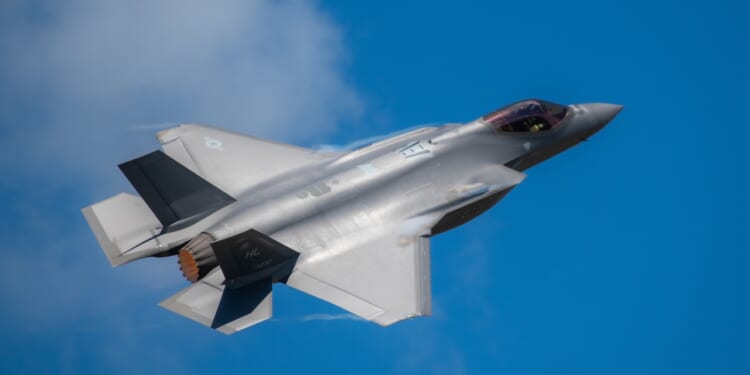The F-35 has more combat experience than the Su-57. But Russian technology in general has fared well in the ongoing Ukraine War, despite Western pressure.
There is a burgeoning arms race between the United States and the Russian Federation, evoking the Cold War. Since 1991, US warplanes have been the undisputed champions of high-end, high-ticket sales on the global arms market. Now, however, things are changing—a direct result of the explosive multipolar world being birthed before our very eyes.
In the decades since the end of the Cold War, China has enjoyed a surge of interest among the Global South, as their equipment is increasingly advanced—and far cheaper than that of America’s. Meanwhile, the Russians, feeling their oats from an advantageous position in Ukraine, are looking to keep their expanded war economy going by selling more systems overseas.
The Su-57 vs. the F-35: A Head-to-Head Comparison
| Aircraft | F-35A Lightning II (USA) | Su-57 Felon (Russia) |
| Year Introduced | 2016 | 2020 |
| Number Built | 1,200+ (all variants) | ~32, including prototypes |
| Length | 51.4 ft (15.7 m) | 20.1 m (66 ft) |
| Wingspan | 35 ft (11 m) | 14.1 m (46 ft 3 in) |
| Weight (MTOW) | 65,918 lb (29,900 kg) | 35,000 kg (77,162 lb) |
| Engines | One Pratt & Whitney F135-PW-100 afterburning turbofan, 28,000 lbf (120 kN) thrust | Two Saturn AL-41F1 afterburning turbofan, 88.3 kN (19,900 lbf) thrust each |
| Top Speed | 700 knots (806 mph, 1,300 km/h) sea level; Mach 1.6 at altitude | 729 knots (839 mph, 1,350 km/h) at sea level; Mach 2.0 at altitude |
| Range | ~670 nmi (770 mi, 1,240 km) combat radius | 1,250 km (780 mi) combat radius |
| Service Ceiling | 50,000 ft (15,000 m) | 20,000 m (66,000 ft) |
| Loadout | One 25mm GAU-22/A 4-barrel rotary cannon; 10 hardpoints (4 internal, 6 external); 18,000 lb (8,200 kg) total payload capacity | One 30 mm Gryazev-Shipunov GSh-30-1 autocannon; 12 hardpoints (6 internal, 6 external); 7,500 kg (16,500 lb) total payload capacity |
| Aircrew | 1 | 1 |
How Are the Russian and American Fighter Jets Different?
Enter the Su-57 Felon. A fifth-generation warplane that is both unique and stylish, many have said it is a real competitor to the F-35, notably on the global arms market. With the breakdown in US-India relations, for example, the prospects of finally breaking off New Delhi from Moscow are increasingly bleak.
Before that breakdown, India was contemplating purchasing the F-35 Lightning II. Today, though, there is much concern about what new warplane the Indians will purchase, because it is obvious that New Delhi will not be buying the expensive F-35. Instead, it is looking to acquire a different fifth-generation warplane—most likely the Russian Su-57, which is much cheaper and has similar capabilities. In a sense, the Russian plane is intended as a stopgap aircraft while New Delhi builds its own Advanced Medium Combat Aircraft.
And should the situation between NATO and the Russian Federation around Ukraine continue to break down—notably seeing Russian breaches of Polish and Estonian airspace in the last week—we might very well see NATO F-35s engaged in combat against Russian Su-57s.
What would such a fight look like?
Understanding the Two Planes’ Weaknesses—and Strengths
First, it is key to understand the strengths and weaknesses these two iconic platforms bring to bear. For the F-35, stealth and network-centric warfare are the priorities. For the Su-57, speed and maneuverability are key.
Most simulations have the F-35 coming out ahead of the Su-57 due to the American plane’s supposed superior detection avoidance and situational awareness. Then again, though, the F-35 has left much to be desired. Its current readiness is below 60 percent, despite the massive cost overruns and production delays that the Pentagon has endured.
What’s more, the plane is so far untested in combat. To be fair, so is the Su-57; even though the Ukraine War has raged for more than three and a half years, the Kremlin has avoided risking its precious handful of Su-57s against Ukrainian air defenses. If a Felon were to be lost in combat to a Ukrainian fighter, or even Ukrainian ground-to-air missiles, the consequences for its viability on the export market could be immense—as French aerospace manufacturer Dassault learned after India’s air force lost at least one of the birds during its brief war with Pakistan in May.
So the F-35 has more combat experience than does the Su-57. But Russian technology in general has fared well in the ongoing Ukraine War, despite all the Western sanctions and pressures imposed upon Moscow by Washington and Brussels. Underestimating the Su-57 would be foolish.
The F-35 excels in terms of its stealth technology. Its radar cross-section (RCS) is very small, thanks to specialized materials that absorb radar waves, making it harder to detect at long ranges. Its design allows it to operate in “beast mode,” carrying external weapons for maximum payload at the cost of stealth. But the fighter comes equipped with internal bays for stealth missions, too.
The Su-57 incorporates stealth features like angled surfaces and radar-absorbent materials, but experts believe that its RCS is higher than the F-35’s, especially from the side or the rear. This could make the Su-57 more vulnerable to early detection.
At the same time, the Su-57’s twin Saturn AL-41F1 engines enable supercruise and supermaneuverability via thrust vectoring, giving it an edge in close-range dogfights where it could out-turn and out-accelerate the F-35. The key for understanding why is that the F-35 is optimized for subsonic stealth operations and simply lacks the Su-57’s raw kinematic performance. In that sense, the Su-57 is closer in design to the US Air Force’s legendary F-22 Raptor, which was built explicitly as an air superiority aircraft.
Both the Su-57 and F-35 carry advanced air-to-air missiles, but the F-35’s Electro-Optical Targeting System (EOTS) and integrated weapons suite allow for precise, long-range engagements. It can carry up to 18,000 pounds of ordnance in non-stealth mode. The Su-57 has a slight edge in the number of hardpoints, and supports a wide array of Russian missiles, including hypersonic weapons—like the R-37M, with a whopping 250-mile range. Furthermore, recent Russian developments to the Su-57 include integrating the plane with drones such as the S-70 Okhotnik, allowing for strikes involving combinations of missiles and hypersonic weapons—massively expanding the Su-57’s raw firepower when compared to the F-35.
So Which Plane Would Win in a Fight?
In a Beyond-Visual-Range (BVR) engagement, the F-35’s superior sensor suite has a clear advantage over the Su-57. The Russian bird would have difficulty evading the F-35’s attacks. On the other hand, as noted above, if the fight devolved into a close-quarters dogfight, the Su-57 would have serious advantages—though it would be unwise to write off the Lightning II altogether, too.
The bottom line is both warplanes are somewhat untested in pure dogfighting conditions. The Su-57 has been mostly kept out of the fighting in Ukraine, while the F-35 has really only conducted bombing runs on ground targets.
More importantly, dogfights between Russian and American warplanes would not be isolated affairs. Such fights would be part of a larger coordinated conflict between many different platforms on both sides, each employing network-centric warfare to best the other.
It really comes down to the “system of systems.” The Russians have proven able to resist NATO capabilities in Ukraine. Then again, though, the Russians have not actually fought American forces directly.
The key point in the Su-57’s favor is its drone integration and the ability to launch hypersonic weapons. While the F-35 has superior BVR warfighting capabilities, it so far lacks the ability to deploy hypersonic weapons or drones, or reliably defend against them. Thus, the Su-57 might have some quiet advantages that the Americans and their NATO partners are not yet factoring into their analyses. But no one can say for certain—and it would be better for the world if it never finds out!
About the Author: Brandon J. Weichert
Brandon J. Weichert is a senior national security editor at The National Interest. Recently, Weichert became the host of The National Security Hour on America Outloud News and iHeartRadio, where he discusses national security policy every Wednesday at 8pm Eastern. He is also a contributor at Popular Mechanics and has consulted regularly with various government institutions and private organizations on geopolitical issues. Weichert’s writings have appeared in multiple publications, including The Washington Times, National Review, The American Spectator, MSN, The Asia Times, and others. His books include Winning Space: How America Remains a Superpower, Biohacked: China’s Race to Control Life, and The Shadow War: Iran’s Quest for Supremacy. His newest book, A Disaster of Our Own Making: How the West Lost Ukraine is available for purchase wherever books are sold. He can be followed via Twitter @WeTheBrandon.
Image: Shutterstock / Faizinraz.


















